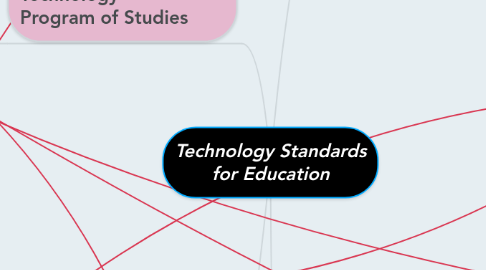
1. Learning and Technology Policy Framework
1.1. 1. Student Centered Learning
1.1.1. Students use technology to support their learning in an creative environment where some of the main goals are to develop competencies in critical thinking, good communication skills, demonstrate ethical digital and global citizenship
1.1.2. Students know how to learn and increase their knowledge and can use technology to demonstrate what they know in different ways
1.2. 2. Research and Innovation
1.2.1. Decision making is based on research and data, Teachers participate in and stay current with technology and learning research to best support students
1.3. 3. Professional Learning
1.3.1. Teachers should be lifelong learners and work to continually research, improve, and create new learning opportunities using digital tools.
1.4. 4. Leadership
1.4.1. Government and school authorities will support the physical infrastructure and develop policies and to support innovative use of technology in school
1.4.2. teachers and other school administrators will model creative, innovative, effective, and ethical use of technology
1.5. 5. Access, Infrastructure, and Digital Learning Environments
1.5.1. The devices and infrastructure; in terms of networks and tech support are available and supported by the administration and the government, and the community.
1.5.1.1. In order for students to learn basic competencies AND more advanced 21st century skills, there must be proper support
2. Information and Communication Technology Program of Studies
2.1. 1. Communicating, inquiring, decision making, and problem solving
2.1.1. Students will use technology in a wide variety of media and tools to communicate, collaborate, create, investigate, and demonstrate their learning
2.2. 2. Foundational operations, knowledge, and concepts
2.2.1. Students will understand the nature and role of technology, and build competencies in skills across a variety of platforms that will transfer to new technologies as they develop
2.3. Students will become discerning cosumers of mass media and digital information
2.3.1. Students will be able to demonstrate understanding of the differences between style and content and and evaluate the authenticity of media and other information
2.4. 4. Students will understand how technology relates to self, work, and society
2.4.1. Students will understand the ethical responsibility of being a digital citizen and have critical thinking skills in regards to mass media consumption.
2.5. 5. Students will respect intellectual ownership and integrity of information
2.5.1. In terms of academic integrity, copyright and content creation
3. A focus on learning the basic, fundamental skills necessary to use technology
4. A focus on life long learning in order to keep current with technological advances and be able to effectively contribute either as a student, or as a teacher, or citizen
5. A focus on creativity and innovation. Creativity is one of the 21st century skills that are important to develop and these are highly valued in Canadian society. Alberta in particular is interested in guiding students towards a more imaginative entrepreneurial mindset.
6. A focus on media literacy, (another 21st century skill) and developing the ability to think critically and analyse information sources, authenticity and bias.
7. The necessity to be comfortable with a wide variety of tools, technology, and media, for many different purposes, so that you can choose the most effective method to achieve your goal.
8. ISTE for Teachers
8.1. 1. Facilitate Student Learning and Creativity
8.1.1. In both virtual, and face to face environments, teachers engage students in active learning, collaboration, and the exploration of real world issues and authentic problems.
8.1.2. Teachers model, promote, and support creativity, innovative thinking, metacognition.
8.2. 2. Design and develop digital age learning experiences and assessments
8.2.1. Use technology to develop new learning experiences and assessments that integrate digital tools and technology to maximize learning and creativity
8.3. 3. Model digital age work and learning
8.3.1. Teachers should keep current with developments so they can support students in a wide variety of ways. Demonstrate their knowledge through observable use of effective tools
8.4. 4. Promote and model digital citizenship and responsibility
8.4.1. Advocate, model and teach digital etiquette as it relates to technology use, social media, copyright and intellectual property rights,
8.4.2. Promote equity and support diversity in terms of access to technology and digital learning, both within the school community and within the global community. Understanding different learning styles and how technology can be used to Develop more nuanced cultural sensitivity through collaboration
8.5. 5. Engage in professional growth and leadership
8.5.1. Contribute to the teaching profession and overall community by modeling leadership qualities and participating in ongoing learning and rresearch to best support the students
9. ISTE for Students
9.1. 1. Empowered Learner
9.1.1. Students actively pursue their own learning, are aware of the ways technology can effectively enhance their experiences. Students know the fundamental concepts and can transfer skills to new technology as time passes
9.2. 2. Digital Citizen
9.2.1. Students learn and demonstrate legal and ethical online etiquette in regard to intellectual property, social media, and safety and security
9.3. 3. Knowledge Constructor
9.3.1. Students are aware of bias and credibility issues with online information and are skilled researchers who can synthesize using a variety of tools and methods
9.4. 4. Innovative Designer
9.4.1. Design is an iterative process that is focused on solving problems within specific constraints. Students can use technologies, tools and processes to create imaginative solutions.
9.5. 5. Computational Thinker
9.5.1. Students are comfortable using technology to analyze data, information and problems from a logical perspective and understand algorithmic thinking and automation.
9.6. 6. Creative Communicator
9.6.1. Students can use technology tools effectively and responsibly for communication and creativity
9.7. 7. Global Collaborator
9.7.1. Students use digital tools to expand their knowledge and understanding of other cultures and broaden their perspective. To connect, collaborate and contribute to solving problems and exploring issues.
